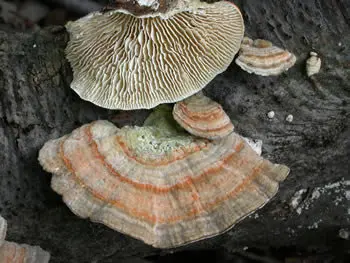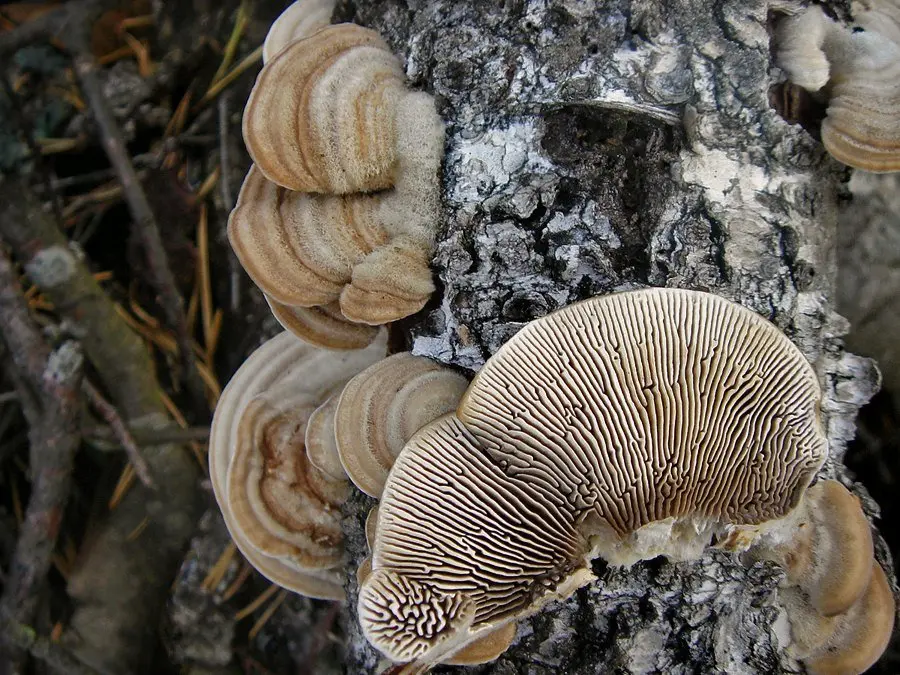Contents
Lenzites birch (Lenzites betulina)
- Division: Basidiomycota (Basidiomycetes)
- Subdivision: Agaricomycotina (Agaricomycetes)
- Class: Agaricomycetes (Agaricomycetes)
- Subclass: Incertae sedis (of uncertain position)
- Order: Polyporales (Polypore)
- Family: Polyporaceae (Polyporaceae)
- Genus: Lenzites (Lenzites)
- Type: Lenzites betulina (Lenzites birch)
 Birch lenzites has many synonyms:
Birch lenzites has many synonyms:
- Lenzites birch;
- Trametes birch;
- Cellularia cinnamomea;
- Cellularia junghuhnii;
- Daedalea cinnamomea;
- Variegated Daedalea;
- Gloeophyllum hirsutum;
- Lenzites flabby;
- Lenzites pinastri;
- Merulius betulinus;
- Sesia hirsuta;
- Trametes betulin.
Birch Lenzites (Lenzites betulina) is a species of fungus belonging to the Polyporaceae family, Lenzites genus. This type of fungus belongs to the category of parasites that cause white rot in natural wood, and also destroy foundations in wooden houses that have not been treated with antiparasitic compounds. The spread of birch lenzites indicates a serious human impact on the environment.
External description of the fungus
Mushroom Lenzites birch (Lenzites betulina) has a fruiting body without a stem, annual, thin and characterized by a semi-rosette shape. Often, mushrooms of this species are located in whole tiers on a fertile substrate. The edges of the caps are sharp, with parameters of 1-5 * 2-10 cm. The upper surface of the cap is a zoned part, the surface of which is covered with a felt, hairy or velvety edge. Initially, it is white in color, but gradually the pubescence darkens, becomes cream or grayish. Often the edge, as it darkens, is covered with algae of various colors.
The pores that make up the hymenophore of the fungus are arranged radially and have a lamellar shape. The pores intertwine with each other, strongly branch, initially have a whitish color, gradually acquire a yellow-ocher or light cream shade. Fungal spores are not colored, they are characterized by the thinnest walls with dimensions of 5-6 * 2-3 microns and a cylindrical shape.
Habitat and fruiting season
Birch Lenzites (Lenzites betulina) can most often be found in the temperate regions of the Northern Hemisphere of the planet. This fungus belongs to the number of saprotrophs, therefore it prefers to live on stumps, fallen trees and dead wood. Most often, of course, mushrooms of this species settle on fallen birches. The fruit body is an annual, it was originally believed that it grows only on birch trees. Actually, that’s why the mushrooms were given the name of birch lenzites. True, it later turned out that lenzites, growing on other types of trees, also belong to the described variety.
Edibility
Lenzites does not contain any toxic components, and the taste of mushrooms of this species is not too unpleasant. However, the fruiting bodies are very rigid, and therefore this mushroom cannot be considered edible.

Similar species, distinctive features from them
If we consider birch lenzites from above, then it strongly resembles some varieties of mushrooms of the species Trametes (Stiff-haired trametes, multi-colored trametes). However, the differences between them can be easily determined by the lamellar hymenophore. Its color in birch lenzites is slightly darker.
Several other species of Lenzites mushrooms also grow in Our Country. These include Lenzites Varne, which grows in the southern parts of Siberia, in the Krasnodar Territory and in the Far East. It is characterized by a large thickness of fruiting bodies and hymenophore plates. There is also Lenzites spicy, belonging to the Far Eastern varieties of mushrooms. Its fruiting bodies are dark in color, and the pulp is characterized by a creamy tint.
Interesting about the origin of the name
For the first time, the description of Lesites Birch was described by the scientist Carl Linnaeus, as part of a combined genus of agaric mushrooms. In 1838, the Swedish mycologist Elias Fries created a new one based on this description – for the genus Lezites. Its name was chosen in honor of the German mycologist Harald Lenz. In the scientific community, this mushroom is often called the female name betulina, originally given by the scientist Fries. However, in accordance with the International Code of Nomenclature for Fungi and Plants, their genera ending in -ites must be presented only in the masculine gender, regardless of the gender in which their name was originally presented. Thus, for the fungi of the described species, the name Lenzites betulinus would be correct.









